 Indians Archive
Indians Archive  Cleveland Indians Top 50 Prospects: #21-30
Cleveland Indians Top 50 Prospects: #21-30
 As we move ever-closer in our march to the #1 overall player in the system (hint: he's an infielder), we get into a pitching-heavy segment of the list. Eight of these next ten players are pitchers, and the two position players are remarkably similar to each other and will be compared to one another throughout their respective carrers as they fight to make it to the big leagues. Two of the system's closers fall in this range, as well as a couple other power relievers and an overslot 2010 draftee.
As we move ever-closer in our march to the #1 overall player in the system (hint: he's an infielder), we get into a pitching-heavy segment of the list. Eight of these next ten players are pitchers, and the two position players are remarkably similar to each other and will be compared to one another throughout their respective carrers as they fight to make it to the big leagues. Two of the system's closers fall in this range, as well as a couple other power relievers and an overslot 2010 draftee.
Here's a link to the intro and prospects #41-50, and #31-40 in case you missed them.
30. Matt Packer, LHP
DOB: 8/28/1987
Height/Weight: 6-0/200
Bats/Throws: L/L
Acquired: 32nd round pick in 2009
2010 Stats: 9-7, 2.04 ERA, 123 K and 22 BB in 132 2/3 IP for low A and AA
 Scouting report: Packer’s fastball generally sits between 90-92 MPH. It has some natural sink to it, and he locates it well and uses it to induce a good amount of groundballs. In addition to the fastball, he throws a curve, slider and change. The best of the three secondary offerings is his changeup, and it helps generate most of his strikeouts. For a guy who has a reputation as more of a command and control lefty, Packer posted an outstanding K/9 rate in Lake County last year of 8.7 in his 95 2/3 innings pitched for the Captains. Packer started out in the bullpen in Lake County, but was moved to the rotation and made 13 starts. He was called up to AA Akron at the end of the season and went a respectable 1-2 with a 3.66 ERA in his 5 starts and one relief appearance for the Aeros down the stretch. For a 32nd round draft pick, pitching in AA in your 1st full professional season is a pretty impressive accomplishment.
Scouting report: Packer’s fastball generally sits between 90-92 MPH. It has some natural sink to it, and he locates it well and uses it to induce a good amount of groundballs. In addition to the fastball, he throws a curve, slider and change. The best of the three secondary offerings is his changeup, and it helps generate most of his strikeouts. For a guy who has a reputation as more of a command and control lefty, Packer posted an outstanding K/9 rate in Lake County last year of 8.7 in his 95 2/3 innings pitched for the Captains. Packer started out in the bullpen in Lake County, but was moved to the rotation and made 13 starts. He was called up to AA Akron at the end of the season and went a respectable 1-2 with a 3.66 ERA in his 5 starts and one relief appearance for the Aeros down the stretch. For a 32nd round draft pick, pitching in AA in your 1st full professional season is a pretty impressive accomplishment.
Packer is 23 years old, so his success in low A last year was primarily against players his age or younger. That is not a knock on him as he of course had no say in his assignment and did anything the Indians asked him to, but it is something to consider when looking at his prospect standing. AA Akron will be a much bigger challenge, especially when it comes to missing bats.
Lefties with 4 pitches don’t exactly grow on trees, and despite being such a late draft choice Packer will have every chance to stick as a starting pitcher. He will likely begin 2011 in the AA rotation, and he’s definitely a guy to keep an eye on as he has already had a good deal of success as a professional. The Indians initially envisioned him as a LOOGY-type guy, but with his four pitches and advance feel for his craft, they are going to give him another shot at proving himself as a starter.
Glass half-full: Packer adds a couple MPH to his fastball and continues his breakout as one of the surprise arms in the system in 2011.
Glass half-empty: He gets moved back to the bullpen and focuses on becoming a lefty specialist.
29. Cory Burns, RHP
DOB: 10/9/1987
Height/Weight: 6-1/180
Bats/Throws: R/R
Acquired: 8th round pick in 2009
2010 Stats: 1-2, 1.96 ERA, 42 SV, 81 K and 14 BB in 55 IP between low A and high A.
Scouting report: Burns has a funky, three-part delivery that is reminiscent of some of the Asian pitchers who come over to MLB. He takes a small, slow step with his left foot, pauses for over a second, then comes to his “balance point” with his back to the hitter, pausing again before coming to the plate. To top it all off, when he finally does deliver the ball it comes from a three-quarters angle rather than over the top to generate more movement on the baseball. It’s a deceptive delivery, and one that he has put a lot of effort into mastering and ensuring that he can repeat it the same way, every time. It really helps him hide the ball from the hitter and helps play up his stuff, which is good but not what anyone would call electric.
Burns tops out in the low-90s with his fastball, and throws a slider and a very good changeup as well. He has an attacking mentality on the mound, and goes right after hitters. He’s a very confident pitcher, and relishes the closer role. I saw Burns pitch the 10th inning of a combined no-hitter for Kinston last year, and it was clear that he wanted to go out there and shut down the opposing hitters to preserve the hard work of his teammates in the prior 9 innings. Burns is the type of guy managers love to have at their disposal, and would run through a brick wall if his coaches or teammates asked him to.
Burns will likely start out 2011 as the closer for AA Akron. He definitely has a closer’s mentality, and is a fun guy to watch pitch. If you see him warming up in the Aeros bullpen, you won’t need to look at the number on his back to figure out who he is. His delivery will be a dead giveaway. When Cleveland starts pilfering the Columbus bullpen, Burns will likely get a chance to pitch at the AAA level at some point in 2011.
Glass half-full: Burns eventually becomes a reliever at the back end of a MLB bullpen
Glass half-empty: Burns’ delivery quits fooling people, and his stuff doesn’t improve enough for him to pitch at the MLB level.
28. Bryan Price, RHP
DOB: 11/13/1986
Height/Weight: 6-4/210
Bats/Throws: R/R
Acquired: In the Victor Martinez deal with the Red Sox. Originally a 1st round sandwich pick of the Red Sox in 2008 (#45 overall)
2010 Stats: 6-3, 1 SV, 3.25 ERA, 69 K and 22 BB in 69 1/3 IP for AA Akron
Scouting report: Price was drafted by the Red Sox out of Rice University, where he had served as their closer. The Sox thought he could start, and moved him into the rotation right away in low A. He continued to start through 2009 when the Indians acquired him, but going into 2010 the decision was made to shift him back to a bullpen role in the Indians organization. He didn’t start a game in 2010, making all 40 of his appearances out of the Akron bullpen. It was a solid move, as Price feels more comfortable pitching in a relief role, and his stuff plays up in the shorter outings.
From the pen, Price throws some serious heat from the right side, sitting at 92-95 and getting it up as high as 97. He has a plus slider that is his strikeout pitch, and scouts consider it a major league quality pitch at this point. In addition to the fastball and slider, Price is working on a splitter that he started throwing in 2010. When it is on, the pitch has good downward bite and hitters tend to beat it into the ground. Price was sent to the Arizona Fall League after the 2010 season primarily to work on the pitch, and had mixed results. His AFL ERA was 5.40 in 11 2/3 innings over 9 appearances. Most of the damage was done early though, and in his last 5 outings spanning 7 IP, Price gave up just one earned run. The splitter will help in his effectiveness against lefties in particular, and will be a slower pitch to complement his fastball and hard slider.
Price tweaked his shoulder last year and spent a few weeks on the DL early in the season. It was his only DL stint in his career, and is hopefully his last. Price can sometimes get a little loose with his mechanics, and needs to concentrate on keeping his delivery clean and repeatable. When he does, he has the stuff to pitch out of the back end of the bullpen. He just needs to keep his delivery clean, trust his stuff, and attack hitters.
Price will begin 2011 at either Akron or Columbus. He’s one of many power arms in the system that will get a shot at earning a bullpen job with the big club either this year or next.
Glass half-full: Price develops his splitter and joins a formidable MLB bullpen.
Glass half-empty: He struggles with command and is effective only against righties.
27. Jordan Henry, OF
DOB: 6/13/1988
Height/Weight: 6-3/175
Bats/Throws: L/R
Acquired: 7th round pick in 2009
2010 Stats: .312/.411/.356 with 0/29 and 29 steals in 449 at bats between high A and AA.
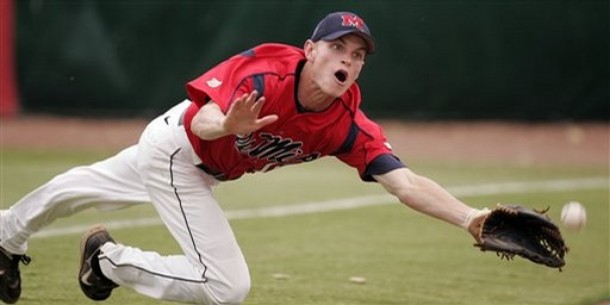 Scouting report: Henry is really, really fast. He covers a lot of ground in centerfield, and is a demon on the basepaths. He stole 29 bases in 2010 and was caught just 6 times. For his professional career, he is an impressive 51-58 in his stolen base attempts. His bat profiles as a true, old school leadoff hitter. He has little to no power, but still finds a way to get on base with walks and singles. Of his 140 hits in 2010, just 16 were for extra bases. In addition to the 140 hits, Henry walked 76 times. His .411 OBP is great to see from a player his age, especially in high A and AA.
Scouting report: Henry is really, really fast. He covers a lot of ground in centerfield, and is a demon on the basepaths. He stole 29 bases in 2010 and was caught just 6 times. For his professional career, he is an impressive 51-58 in his stolen base attempts. His bat profiles as a true, old school leadoff hitter. He has little to no power, but still finds a way to get on base with walks and singles. Of his 140 hits in 2010, just 16 were for extra bases. In addition to the 140 hits, Henry walked 76 times. His .411 OBP is great to see from a player his age, especially in high A and AA.
Henry is a very similar player to 2010 draftee Tyler Holt. He’s probably faster than Holt, and Holt has a little more pop. It will be very interesting to see how these two players careers develop, since they are so similar stylistically and so close in age.
Henry should start 2011 as the leadoff hitter for AA Akron, and could steal a LOT of bags in the Eastern League this year.
Glass half-full: A leadoff hitting CF who steals 35-40 bags a year
Glass half-empty: A 4th OF with speed, and a reliable pinch runner
26. Josh Judy, RHP
DOB: 2/9/1986
Height/Weight: 6-4/200
Bats/Throws: R/R
Acquired: 34th round pick in 2007
2010 Stats: 3-0, 2 SV, 2.94 ERA, 57 K and 14 BB in 49 IP between AA and AAA
Scouting report: Judy has been as consistent of a player as you will find in the Indians organization. In four seasons as a professional, Judy’s 'highest' ERA was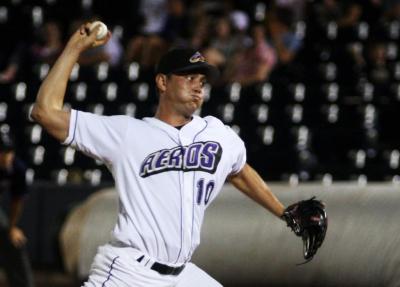 the 2.94 he posted last year between Akron and Columbus. He has struck out more hitters than innings pitched every year since 2008. He gets a lot of groundball outs, keeps the ball in the ballpark, and doesn’t walk a lot of hitters. In short, Judy does an outstanding job of controlling the things he can control and lets his defense handle the rest.
the 2.94 he posted last year between Akron and Columbus. He has struck out more hitters than innings pitched every year since 2008. He gets a lot of groundball outs, keeps the ball in the ballpark, and doesn’t walk a lot of hitters. In short, Judy does an outstanding job of controlling the things he can control and lets his defense handle the rest.
Judy sets everything up with a fastball that sits comfortably in the low-90s, and can touch as high as 96. It has natural sinking action, and helps him get plenty of groundballs. He compliments the fastball with a plus slider that generates lots of swings and misses. The slider has sharp, late break, and is only a few MPH slower than the fastball making pitch recognition difficult for hitters. He has a “show-me” changeup, and only uses it on occasion to change speeds and keep hitters honest. His bread and butter is his fastball/slider combo, and as a reliever that should be enough. He has closer experience, as he was successful in that role for AA Akron in 2009 when Vinnie Pestano was having his elbow problems. He has no problem pitching in pressure situations, and will be able to handle a late inning role at the major league level. He might never be a closer in the major leagues long-term, but will almost certainly pitch in the late innings. He is close to a finished product, without much more projection, but he has a very high floor as well.
Judy will be considered for a spot in the MLB bullpen out of spring training. If he misses out on a job with the big club, he will begin 2011 where he left of in 2010, in the AAA Columbus bullpen. Either way, you’re likely to see Judy pitch in Progressive Field at some point in 2011.
Glass half-full: Judy becomes a consistent 8th inning option for the Indians.
Glass half-empty: It’s difficult not to imagine Judy finding at least some measure of success in a major league bullpen.
25. Tyler Holt, OF
DOB: 3/10/1989
Height/Weight: 5-11/190
Bats/Throws: R/R
Acquired: 10th round pick in 2010
2010 Stats: .286/.409/.457 with 0/8 in 70 AB for low A Lake County
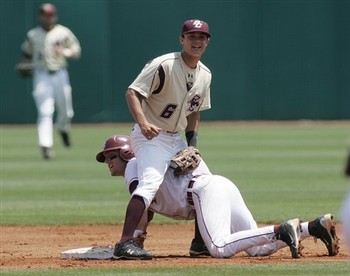 Scouting report: Holt was selected last year in the 10th round out of Florida State. He signed for half a million dollars, and then made his pro debut the same day, going 1-4 with a triple. He’s an extremely intense competitor, and really wears his emotions on his sleeve which can sometimes get him into trouble on the field. He has good speed in the outfield, and stole 5 bases in 8 attempts last year.
Scouting report: Holt was selected last year in the 10th round out of Florida State. He signed for half a million dollars, and then made his pro debut the same day, going 1-4 with a triple. He’s an extremely intense competitor, and really wears his emotions on his sleeve which can sometimes get him into trouble on the field. He has good speed in the outfield, and stole 5 bases in 8 attempts last year.
For a college player who signed at the deadline and was thrown into the middle of a professional pennant chase, Holt had a great debut in 2010. He showed an advanced approach, walking 15 times against just 12 strikeouts for Lake County. His bat profiles best in CF, but it’s possible that he eventually ends up in LF. The Indians think he can stick in CF, and the playing time he got in LF was mainly because of the presence of Delvi Cid in Lake County last year. I hesitate to call him a “grinder” because of the negative connotation that term has in Cleveland after Eric Wedge’s somewhat liberal use of the term…but he really is a grinder. He profiles as a classic top of the order hitter who can get on base and then do some damage once he gets there.
Holt should open up 2010 in CF for high A Kinston. The pitcher-friendly Carolina League will be a tough test for him in his first full professional season, but he should be up to the challenge
Glass half-full: A CF with a little pop, and gets on base a lot.
Glass half-empty: A LF with speed and not much pop
24. Vinnie Pestano, RHP
DOB: 2/20/1985
Height/Weight: 6-0/205
Bats/throws: R/R
Acquired: 20th round pick in 2006
2010 Stats: 2-3, 17 saves, 1.81 ERA, 77 K and 16 BB in 59 2/3 IP between AA and AAA
Scouting report: Pestano throws from a low three quarters arm slot, and is nearly impossible for righties to hit. He’s an intense competitor with a closers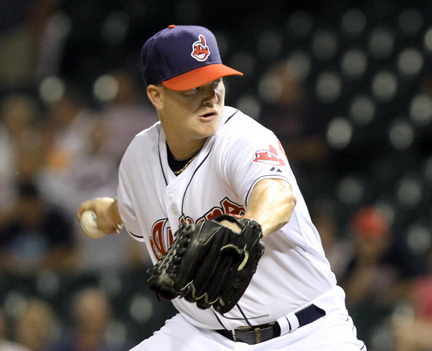 mentality who was a successful college pitcher at Cal State Fullerton, one of the best programs in all of collegiate baseball. Pestano works primarily off a low-90s fastball that has touched 95. He throws both a four-seamer that has a little more giddyup and a two seamer that has more movement. The two seamer from the ¾ delivery is a nasty pitch that really runs in on righthanded hitters. In addition to the fastballs, Pestano throws a hard slider that flashes plus, and is a true swing and miss offering. It’s another pitch that improved with his new arm slot, and it is still getting better as he refines it.
mentality who was a successful college pitcher at Cal State Fullerton, one of the best programs in all of collegiate baseball. Pestano works primarily off a low-90s fastball that has touched 95. He throws both a four-seamer that has a little more giddyup and a two seamer that has more movement. The two seamer from the ¾ delivery is a nasty pitch that really runs in on righthanded hitters. In addition to the fastballs, Pestano throws a hard slider that flashes plus, and is a true swing and miss offering. It’s another pitch that improved with his new arm slot, and it is still getting better as he refines it.
There’s no doubting Pestano’s ability to get hitters out. The issue with Vinnie is his checkered injury history. He had Tommy John surgery in 2006, and had to be shut down at the end of the 2009 season due to elbow issues. After the elbow shut him down in 2009, Pestano raised his arm angle from sidearm to a low three quarters slot, and that helped him make it through 2010 healthy and effective. He had gone to the sidearm delivery in college, and while it did help him get drafted it wasn’t doing any favors for his health. The move from sidearm to three quarters didn’t hurt him on the hill, as he posted his best numbers as a professional in 2010. He’s an extremely hardworking player who has busted his tail to rehab from his various injuries, and has a true closer’s mentality on the mound. He attacks hitters, trusts his stuff and never gives up on an at bat. He’ll have a hard time unseating Chris Perez for the closer role in Cleveland, but his experience as a closer throughout the minors will help him in the back end of a MLB bullpen regardless. He's an absolute nightmare for right handed hitters.
In his 5 innings last year in Cleveland, Pestano walked 5, struck out 8, gave up 2 ER and recorded his first major league save. He should begin 2011 as the closer for AAA Columbus, and will almost certainly pitch in Cleveland at some point during the season. .
Glass half-full: Pestano becomes a dominant setup man.
Glass half-empty: Injury problems continue to plague him, and he never gets an opportunity to help the big league club.
23. T.J. House, LHP
DOB: 9/29/1989
Height/Weight: 6-2/215
Bats/Throws: R/L
Acquired: 16th round pick in 2008
2010 Stats: 6-10, 3.91 ERA, 106 K and 61 BB in 135 2/3 IP for high A Kinston
 Scouting report: House was drafted out of high school in 2008, and the Indians paid overslot money at the deadline to sign him away from a scholarship to Tulane. He’ll pitch all of 2011 as a 21-year old, so he’s ahead of the developmental curve with a full season at high A under his belt. House sets everything up with his fastball, which sits in the low-90s and has good, natural sinking action. House’s best secondary offering is his changeup, which is probably the best in the system. It is a good 10 MPH slower than his fastball, but he keeps a very consistent arm action that helps fool hitters, and the pitch has good down and away action from left handed hitters and down and in on righties. It’s really a great weapon to have to help him attach hitters on both side of the plate. To go with the fastball and changeup, House also has a pretty nasty slider that gives left handed hitters fits.
Scouting report: House was drafted out of high school in 2008, and the Indians paid overslot money at the deadline to sign him away from a scholarship to Tulane. He’ll pitch all of 2011 as a 21-year old, so he’s ahead of the developmental curve with a full season at high A under his belt. House sets everything up with his fastball, which sits in the low-90s and has good, natural sinking action. House’s best secondary offering is his changeup, which is probably the best in the system. It is a good 10 MPH slower than his fastball, but he keeps a very consistent arm action that helps fool hitters, and the pitch has good down and away action from left handed hitters and down and in on righties. It’s really a great weapon to have to help him attach hitters on both side of the plate. To go with the fastball and changeup, House also has a pretty nasty slider that gives left handed hitters fits.
House had a very solid season for Kinston in 2010, and did a great job getting groundballs and keeping the ball in the ballpark. He’s still more about projection than results at this point, as he hasn’t shown a consistent ability to miss bats at this stage of his career.
Glass half-full: House fills out his frame, adds more strength in his lower half, picks up a few MPH on his fastball and becomes a good #3 or even a #2.
Glass half-empty: House struggles to miss bats and finds that the higher levels and better hitters make it tougher to keep the ball in the ballpark.
22. Kyle Blair, RHP
DOB: 9/27/1988
Height/Weight: 6-3/205
Bats/Throws: R/R
Acquired: 4th round pick in 2010
2010 Stats: Signed late, did not play
Scouting report: Going into his senior season at San Diego, Blair was seen as a potential first round pick. He was a fifth round pick of the Dodgers coming out of high school, but didn’t get the money he was looking for and went to college. He never really took a huge leap in development in college, pitching well but never really blowing guys away. He has a starter’s arsenal, throwing four average-to-plus pitches. His fastball sits in the low 90’s, and is probably his 3rd best pitch. He has had some command issues with the fastball in the past, and it isn’t fast enough for him to throw it by major league hitters if he cannot command it effectively. It does have some natural sink to it, so if he can solve his command issues it would go a long way in making him a more surefire bet to start in the big leagues someday. His best pitch is his slider, and most scouts think it can be a plus pitch in the major leagues down the road. He would sometimes run into trouble in college when he became overly reliant on the pitch. He also throws a changeup that is already above average, and could be plus. His curveball is his fourth-best pitch, but flashes average and should improve with time.
Blair was a workhorse in college, as he was the #1 starter for a nationally ranked USD squad. He’s seen more of an innings-eater, middle of the rotation type than a potential #1. Scouts don’t see too much projection in his frame, with Baseball Prospectus’ Kevin Goldstein calling him “an is-what-he-is type as opposed to projectable arm.” Still, despite not having a sky-high ceiling, Blair as seen as a guy with a pretty high floor. His deep arsenal of pitches will likely afford him the opportunity to pitch in the big leagues in a few years.
Blair’s initial professional assignment will depend on how things shake out in spring training. But he’ll get a shot to pitch his way to the Kinston rotation, and worst case he’ll have a starting spot in Lake County.
Glass half-full: A #3 starter who can pitch to contact and outsmarts hitters consistently.
Glass half-empty: A right-handed Jeremy Sowers.
21. Austin Adams, RHP
DOB: 8/19/1986
Height/Weight: 5-11/185
Bats/Throws: R/R
Acquired: 5th round pick in 2009
2010 Stats: 8-5, 2.49 ERA, 112 K and 36 BB in 112 IP between low A and high A
Scouting report: Adams took a big step forward in 2010 by putting together an outstanding season across two A levels. The Indians had Adams pitching out of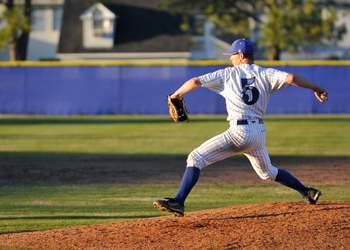 the bullpen for Mahoning Valley in 2009, but they moved him back to the starting rotation in Lake County last year as a “piggyback” guy. Adams would start a game, then come in out of the bullpen in his next appearance. He responded by putting up a breakout season where he posted an even 9.0 K/9 rate, and went 6-1 with a 1.53 ERA at high A Kinston.
the bullpen for Mahoning Valley in 2009, but they moved him back to the starting rotation in Lake County last year as a “piggyback” guy. Adams would start a game, then come in out of the bullpen in his next appearance. He responded by putting up a breakout season where he posted an even 9.0 K/9 rate, and went 6-1 with a 1.53 ERA at high A Kinston.
Adams also played SS in college, and is somewhat raw as a pitcher. He started, closed and played SS for NAIA Faulkner University. He’s a great athlete who looks comfortable on the mound, and has a clean, low effort delivery. He has tremendous arm strength, which is a good thing because righties who are shorter than 6’ had better be able to pitch in the mid-90s to be considered prospects. His fastball sits between 93-95 consistently, and can touch 98. He complements the plus heat with a very good, hard curveball, and a changeup that still need refined to be more of a consistent pitch. When you consider how inexperienced Adams is as a pitcher, you really have to like the kind of numbers that he was able to put up last season.
The 112 innings Adams threw last year was a career high, and the Indians are going to have to take it slow with the converted infielder. It seems like they still want to see if they can groom him as a starter, so expect to see his total innings take another jump in 2011. He should start of 2011 in Akron, either in another piggyback starter role or possibly out of the bullpen. He’s definitely a guy to keep an eye on, as he wasn’t seen as a top-25 guy entering 2010, but could be a top-10 guy by the time 2012 rolls around.
Glass half-full: Adams refines his changeup, builds up his arm strength and sticks in the rotation, where his stuff could make him a solid #3 or even a #2.
Glass half-empty: Adams can’t stick in the rotation, but still finds success as a power reliever.
- NBA Announces 2013-2014 Schedule
- Browns Ink Sharknado
- Sharknado A No-Show For Rookie Camp
- Trent Richardson Out Until Training Camp
- Browns Sign Brandon Jackson
- Carrasco Suspended Eight Games
- Browns Add to Wide Receiver Depth with David Nelson
- Browns Need to Learn from Past Draft Mistakes
- Browns Release Chris Gocong and Usama Young
- Browns Missing on Grimes Disappointing, But Not The End
The TCF Forums
- Chris Grant's first 3 drafts
Kingpin74 (Tuesday, January 21 2014 10:13 AM) - The 2014 Offseason Thread
googleeph2 (Tuesday, January 21 2014 9:36 AM) - 2015 Recruiting
furls (Tuesday, January 21 2014 6:57 AM) - Mike Brown
YahooFanChicago (Monday, January 20 2014 11:15 PM) - Movies coming out
HoodooMan (Monday, January 20 2014 9:34 PM) - 2014 Hoops Hockey Hijinx
jpd1224 (Monday, January 20 2014 4:44 PM) - 2014 Recruiting
jclvd_23 (Monday, January 20 2014 2:26 PM) - Wish List - #4 Pick
Hikohadon (Monday, January 20 2014 1:26 PM) - Official- Browns Coach Search/Rumors
OldDawg (Sunday, January 19 2014 6:48 PM) - #1 overall pick Anthony Bennett
TouchEmAllTime (Sunday, January 19 2014 1:28 PM)


